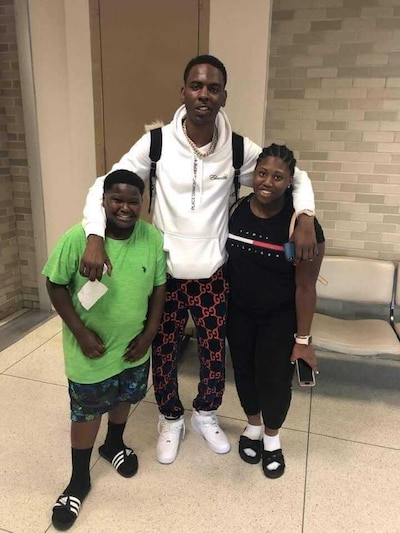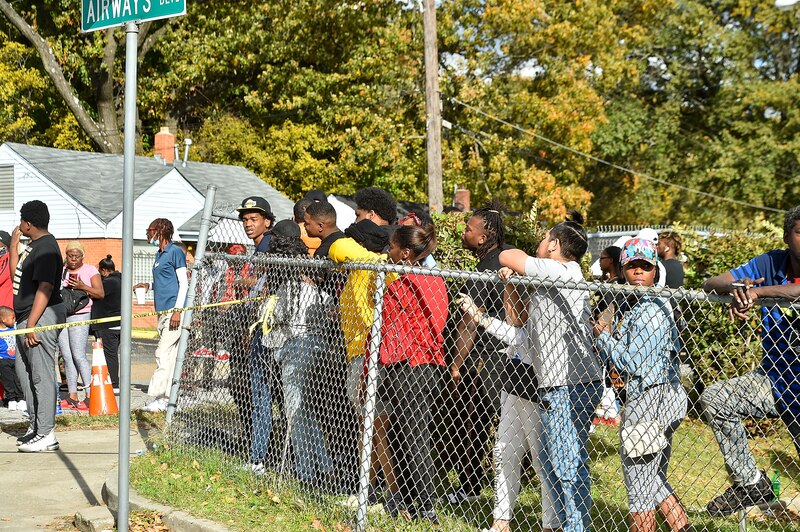Just before school dismissal on Wednesday afternoon, cell phones across Memphis erupted with text messages, notifications, and calls as Memphians shared the news that Young Dolph had been shot and killed in broad daylight at a local cookie shop. Adolph Robert Thornton, Jr., often just called Dolph, was a Chicago-born, Memphis-raised rapper whose slick lyrics epitomized the Bluff City’s grit and grind culture and attracted scores of young fans.

As the crime scene in front of Makeda’s Cookies filled with onlookers, an 11-year-old boy openly wept about the death of his “favorite rapper.” On social media, teachers discussed how to comfort both their students and their own children. “Students will be grieving,” one educator posted.
Chalkbeat asked school psychologist Dr. Kay Streeter how teachers and parents should talk to their children about trauma and the gun violence epidemic in the wake of Young Dolph’s death. One tip she shared is to ask students how an event has affected a friend.
“Sometimes kids don’t want to talk directly about themselves, but they’re more than happy to gossip about someone else. So they can talk about what a ‘friend’ experienced,” said Streeter, “even if that friend is imaginary.”
Streeter, who is also a contributor on WLOK radio station, shared her Five K’s of Being OK and other coping strategies that teachers and caregivers can use to help their students and themselves during difficult moments.
This interview has been lightly edited for length and clarity.
A: Young Dolph’s music struck a chord with a lot of the students and children that you work with. His content was explicit, but he had a lot of young fans. Why do you think so many Memphis children connected with him?
Q: Because I think so many Memphis children are looking for a way out of a hopeless situation, and when you see someone who looks like you, who came from the same situation you’re currently in, and you see that they basically pulled themselves up by their own bootstraps and were able to actually get out there and become successful, do things that are positive and also help others along the way, that gives hope to you as well. So representation is very important. And he looked like, he sounded like, and behaved like kids I serve every day.
It just really struck my heart to see yet another person killed in Memphis in daylight, in a public place, doing something regular, going to get cookies, you know. Going to the store. Crossing the street. All of this violence is really causing a lot of trauma for our children, for our parents, for our teachers, for every one. And years from now, we will look back and see how all of this trauma has affected all of us.
Q: How does trauma and secondhand trauma impact children? What are some signs that a student might be experiencing trauma or secondhand trauma in the classroom?
A: Secondhand trauma is basically you’re experiencing some of the same symptoms that a person with post traumatic stress syndrome would experience, but you didn’t directly experience the traumatic event.
So when teachers are looking at their students, they may see what I call one of the Detrimonious D’s: destructive behavior, disruptive behavior, disengagement, dreamy behavior such as falling asleep or daydreaming, dreary behavior, such as being sad, or danger obsession which is hypervigilant behavior. So you may see some of that in your classroom. You may see kids being disruptive, not paying attention, destructiveness, tearing up things, because they’re trying to deal with a lot of different feelings that are happening all at once and trying to process what they just saw or heard about.
Q: What should you do if you notice these things with your students in the classroom?
A: I give teachers something really quick and easy that they can do that I know will be effective, which is doing a quick check-in at the beginning of class everyday. You stand at your door, and basically you ask them to check in as they walk into the door with either a thumbs up for ‘I’m doing okay’ or a thumbs down for ‘I’m not doing well today.’ And so if everybody has a thumbs up, that’s great. If you see a few with thumbs down, pull them to the side, and say, “Hey, what’s going on? Is it something that you need to talk with me about?”
It could be they just need a moment to regroup, a moment to think, a moment to chat, or they may need some moments with a professional school guidance counselor or with a social worker. But at least you’re separating who needs immediate help right away.

Q: We’ve had so much gun violence this year in Memphis, but this is not unique to Memphis; this is not unique to Shelby County Schools. One of the unfortunate impacts of the pandemic is the increase in gun violence. How is that affecting schools?
A: It’s quite detrimental to the learning process in that you have children who’ve been traumatized. So that immediate trauma can interfere with their ability to pay attention. Then you have the Detrimonious D behavior going on — destruction and being disruptive and disengaged. Then you may have teachers who are experiencing burnout or trauma themselves, or even administrators. So it’s almost like you have a situation where everyone is feeling hurt. So we’re all just trying to survive, rather than really thrive during this time, and I think that’s okay. Because these are times we’ve never experienced before, like no other time, and hopefully we won’t experience them again.
What I say in general to people is, Hey, you don’t have to be great right now. You just have to be okay. That’s it. All you have to be is okay, and I have Five K’s of Being OK
Q: Our educators, administrators, and superintendent carry a lot on their shoulders. Do you have any thoughts on how they can care for their students while also caring for themselves?
A: You have to go home and cut it off. You can’t care 100% all day long 100% of the time. So when you get home, you may have to care a little less. Don’t keep thinking about Johnny all day long. And then you talk about Johnny all night long. Because then when you get back to school to deal with Johnny, you’re sick of Johnny. So you have to cut it off. Do something else. Disengage. Do something that’s only about you, so that you can refuel, regenerate, and deal with Johnny with fresh eyes the next day. So have a stopping point, have some boundaries.
All you can do every day is to do the best job that you can do. And then lay it down and move forward. You have to lay it down, move forward, and rely on each other. Remember those Five K’s of Being OK. Keep talking, keep thanking, keep planning, keep breathing, and keep forgiving. And the number one person you must forgive first is yourself.


